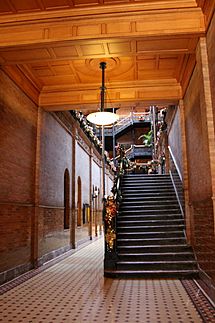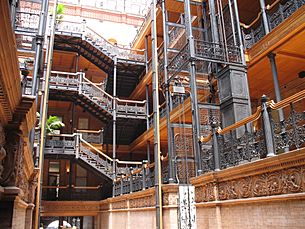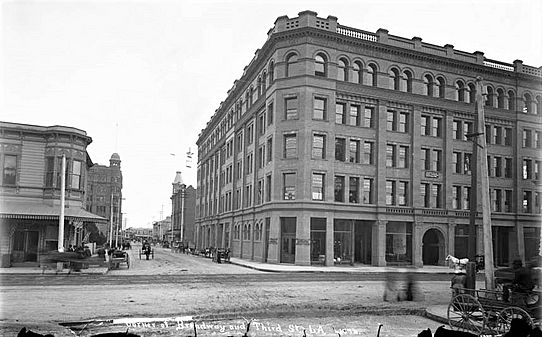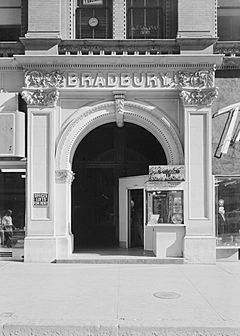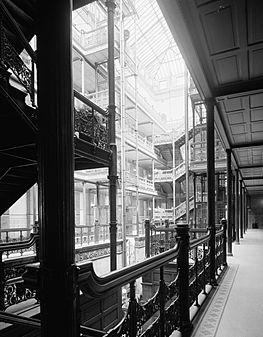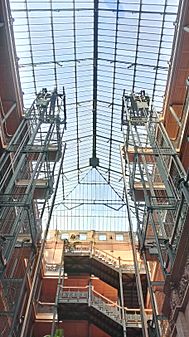Bradbury Building facts for kids
|
Bradbury Building
|
|
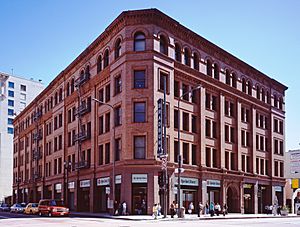
From the corner of West 3rd Street and South Broadway (2005)
|
|
| Location | 304 South Broadway Los Angeles, California |
|---|---|
| Built | 1893 |
| Architect | Sumner Hunt, George Wyman |
| Architectural style | Italian Renaissance Revival, Romanesque Revival, Chicago School |
| NRHP reference No. | 71000144 |
Quick facts for kids Significant dates |
|
| Added to NRHP | July 14, 1971 |
| Designated NHL | May 5, 1977 |
The Bradbury Building is an architectural landmark in downtown Los Angeles, California. Built in 1893, the five-story office building is best known for its extraordinary skylit atrium of access walkways, stairs and elevators, and their ornate ironwork. The building was commissioned by Los Angeles gold-mining millionaire Lewis L. Bradbury and constructed by draftsman George Wyman from the original design by Sumner Hunt. It appears in many works of fiction and has been the site of many movie and television shoots and music videos.
The building was added to the National Register of Historic Places in 1971, and was designated a National Historic Landmark in 1977, one of only four office buildings in Los Angeles to be so honored. It was also designated a landmark by the Los Angeles Cultural Heritage Commission and is the city's oldest landmarked building.
Contents
History
19th century
Lewis L. Bradbury (November 6, 1823 – July 15, 1892) was a gold-mining millionaire – he owned the Tajo mine in Sinaloa, Mexico – who became a real estate developer in the later part of his life. In 1892 he began planning to construct a five-story building at Broadway and Third Street in Los Angeles, close to the Bunker Hill neighborhood. A local architect, Sumner Hunt, was hired to design the building, and turned in a completed design, but Bradbury dismissed Hunt's plans as inadequate to the grand building he wanted. He then hired George Wyman, one of Hunt's draftsmen, to do the design. Bradbury supposedly felt that Wyman understood his own vision of the building better than Hunt did, but there is no concrete evidence that Wyman changed Hunt's design, which has raised some controversy about who should be considered to be the architect of the building. Wyman had no formal education as an architect, and was working for Hunt for $5 a week at the time.
The building opened in 1893, some months after Bradbury's death in 1892, and was completed in 1894, at the total cost of $500,000, about three times the original budget of $175,000.
20th century
The building has operated as an office building for most of its history. It was designated a National Historic Landmark in 1977. It was purchased by noted developer and champion of downtown restoration Ira Yellin in the early 1980s, who invested $7 million in restoration, preservation, and seismic retrofitting between 1989-1991. As part of the restoration, a storage area at the south end of the building was converted to a new rear entrance portico, connecting the building more directly to Biddy Mason Park and the adjacent Broadway Spring Center parking garage. The building's lighting system was also redesigned, bringing in alabaster wall sconces from Spain.
Since 1996, the building has served as the headquarters for the Los Angeles Police Department's Internal Affairs division and other government agencies. The LAPD Board of Rights holds officer discipline hearings here, and within the force it is given the nickname "the Ovens", because officers see it as the place they "get burned." The LAPD has a 50-year lease on their space.
21st century
The building was purchased for $6 million in 2003 by a Hong Kong investor, less than the $7 million Ira Yellin invested just to rehabilitate and seismically retrofit the structure after acquiring it in 1989, a reflection of Yellin's commitment to downtown preservation and restoration. It was never listed for sale, only offered to a select group of potential buyers who would respect its legacy and retain its character. The building, according to Yellin’s widow, Adele, at the time, was “in very good hands”.
From 2001 to 2003 the Museum of Architecture and Design had its home there. In 2007, the Morono Kiang Gallery of Chinese art opened in the building.
As of 2018[update], the Berggruen Institute maintains its offices in the building.
Architecture
The building's undistinguished exterior facade of brown brick, sandstone and terra cotta detailing was designed in the commercial vernacular Italian Renaissance Revival style current at the time. Its interior is its most notable part.
The narrow entrance lobby, with its low ceiling and minimal light "has the look of a Parisian alley of arched windows", and opens into a bright naturally lit great "awe-inspiring cathedral-like" center court. Robert Forster, star of the TV series Banyon that used the building for his office, described it as "one of the great interiors of L.A. Outside it doesn't look like much, but when you walk inside, suddenly you're back a hundred and twenty years."
The five-story central court features glazed and unglazed yellow and pink bricks, ornamental cast iron, tiling, Italian marble, Mexican tile, decorative terra cotta and polished wood, capped by a skylight that allows the court to be flooded with natural rather than artificial light, creating ever-changing shadows and accents during the day. At the time the building was completed, it featured the largest plate-glass windows in Los Angeles.
Open "bird-cage" elevators surrounded by wrought-iron grillwork go up to the fifth floor.
Geometric patterned staircases and wrought-iron and polished oak railings are used abundantly throughout. The wrought-iron was created in France and displayed at the 1893 Chicago World's Fair before being installed in the building. Freestanding mail-chutes also feature ironwork. The overall effect, according to a Los Angeles Times writer, is "a mesmerizing degree of symmetry and visual complexity".
Tourism
The building is a popular tourist attraction. It is open daily and staffed by a government worker who provides historical background on it. Casual visitors are only permitted up to the first landing. Brochures and tours are also available. It is close to three other downtown Los Angeles landmarks: the Grand Central Market, the Million Dollar Theater (across the street) and Angels Flight (two blocks away). Access is via the Los Angeles MTA Red Line's Civic Center exit, three blocks distant.
Gallery
Images for kids
See also
 In Spanish: Bradbury Building para niños
In Spanish: Bradbury Building para niños





